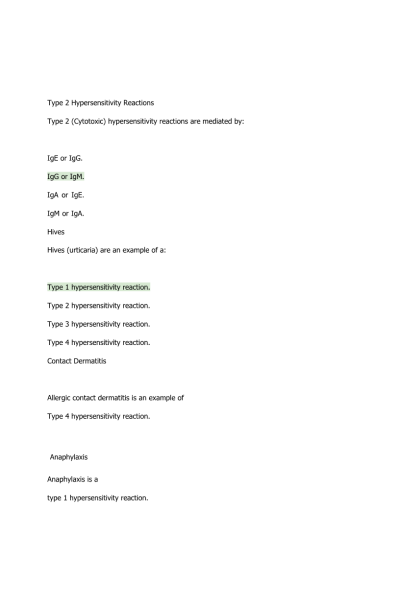Type 2 Hypersensitivity Reactions
Type 2 (Cytotoxic) hypersensitivity reactions are mediated by:
Hives (urticaria) are an example of a:
Type 1 hypersensitivity reaction. Type 2 hypersensitivity reaction. Type 3 hypersensitivity reaction. Type 4 hypersensitivity reaction. Contact Dermatitis
Allergic contact dermatitis is an example of Type 4 hypersensitivity reaction.
type 1 hypersensitivity reaction.
Immune System
Which of the following are considered the “first responders” of the innate immune system?
Hypersensitivity Reactions
In summary, we reviewed the four types of hypersensitivity reactions. For each type, the pathophysiology was reviewed. Clinical applications were provided that illustrated the need to understand the underlying pathophysiology in order to explain the symptoms and select appropriate treatment. The table below compares and reviews each type of allergic reaction that we discussed. Can you match the proper type to the mechanism, example, and pathophysiology?
Type |
Mechanism |
Example |
Pathology |
Type II |
Tissue-specific destruction or impairment because of:
|
1-ABO incompatibility 5-Graves' disease |
1-Complement damages RBC membrane and cells lyse
5-Autoantibodies specific for thyroid tissue impair receptor for TSH |
Type IV |
Cytotoxic T cell-mediated |
Contact dermatitis (e.g., poison ivy) |
T cells attack tissue directly (no antibody) |
Type I |
IgE action on mast cells |
Hay fever |
Mast cell degranulation results in an inflammatory response |
Type III |
Antigen-Antibody complex deposited in tissues |
Raynaud’s phenomenon |
Complex deposited in small peripheral vessels in cool temperatures leading to vasoconstriction and blocked circulation |
ABO Incompatibility
Damage occurs with ABO incompatibility because:
Mast cell degranulation.
Autoantibodies specific for thyroid tissue impairs the receptors for TSH.
Complement damages RBC membrane causing cell lysis. Antigen/Antibody complexes........... Continue
| Instituition / Term | |
| Term | Year 2022 |
| Institution | NR 507 Advanced Pathophysiology |
| Contributor | Mireille |






























